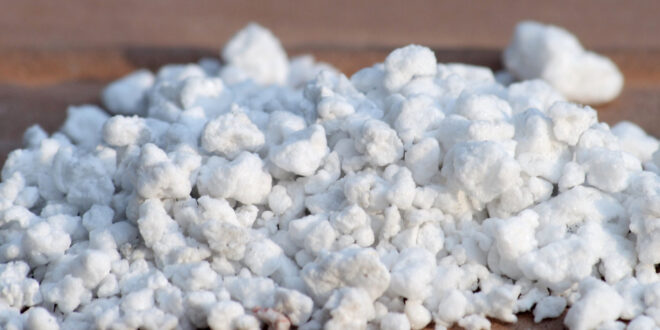If you’ve ever walked through a garden centre and encountered shelves of mysterious (but natural-looking) substances, chances are you’ve kept on walking. We don’t blame you. Powders, potions, and bags of everything from crumbling pebbles to grimy grit, can be completely bewildering and thoroughly off-putting. The thing is – if you only knew the value of these soil additives to your garden, you might be tempted to linger a little longer! That’s why we’ve done the homework for you. We’re starting with perlite, but there’ll be more – so be sure to look out for these fascinating garden products in following articles.
Praise for perlite
It’s light, snow-white and looks like miniature grains of popped corn, but perlite is most definitely not for eating. It’s also not intended as a food for your plants – but it will keep their roots in great shape – and that’s the key to healthy plant growth.
In its original form, perlite is is a glassy volcanic rock which actually contains water. To create the perlite you see on the garden centre shelves, the rock is heated to over 800°C, at which stage, it really does pop – expanding up to 20% or it’s original size! But chemistry aside, perlite is as essential to the gardener as salt is to the cook! That’s because perlite is a triple action additive.
Perlite has the unique ability to hold just the right amount of moisture in the soil while simultaneously encouraging excess moisture to drain away. It creates essential air pockets in the soil so oxygen can reach roots. But wait – there’s more! Perlite conveniently has a neutral pH level, so when you use it in your garden, it won’t affect the acid-alkaline balance of the soil. It really is a ‘what’s not to love’ garden product.
The reason perlite can retain moisture, is that it’s porous. However, it also refuses to be squished, even when under pressure. So, when the garden comes under threat of compression (from your foot, for example, when you tread on the ground), perlite helps keep the soil structure open, and the moisture flowing through it. This same open structure is what allows oxygen to penetrate down to the roots, dependent on it for good health.
Perlite in its place
Perlite is useful in so many aspects of gardening. Unless it is already an ingredient in seed raising mixes, perlite of a fine grade can be incorporated into seed sowing soils to help with drainage and to stop tiny seeds and seedlings drying out. Medium grade perlite is perfect in cacti and seedling growing mixes. It can even be used as a mulch around seedlings to help prevent them drying out. Outdoors, coarse grade perlite can be mixed into heavy soils to help with drainage. Best of all, perlite is inorganic (not from living material), so it won’t break down over time as compostable materials do.
How to use perlite in your gardening
Perlite isn’t a fertilizer, and doesn’t contain chemical salts which can damage plant roots. However, if it is over-used, it will encourage nutrients to pass so quickly through a growing medium, roots don’t have time to absorb the feed you’re offering. The recommended ratio of perlite to soil or growing medium is 1:3. However, this should be adapted according to the plants you are working with.
Is perlite an environmental choice?
Like almost every gardening product, perlite has it’s pros and cons in terms of its effect on the environment. It is certainly a non-renewable resource, but only a tiny (think just a few square kilometres) of the land area of the earth is used in mining it, and no chemicals are used in the process. It remains in the soil rather than breaking down, so it can be reused again and again. That said, energy is used to heat it, and it is a bulky (although light) material to transport. When deciding if you want to use perlite, research the options (which include pumice, peat, and vermiculite).
Word of warning
Perlite is a very light, dusty material. Always research potential health warnings before using it, and wear a mask when working with it.










Join the Discussion
Type out your comment here:
You must be logged in to post a comment.